|
|
Chapter 6. Cover Data
| The books tell us how to play and bet. Then they give us statistics
telling us how much we will win. Then they tell us we can't actually
play that way as we'll be thrown out. This chapter spends some time
looking at the costs associated with not playing ideally.
"You Can't Get There from Here" — Ogden Nash,
1957
| |
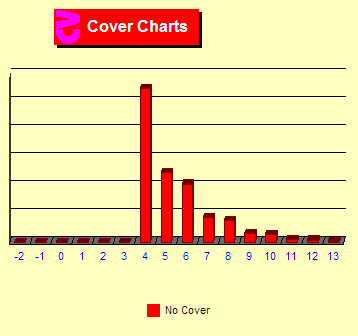 How
does cover betting affect max bets? How
does cover betting affect max bets?
To avoid looking like a card counter and being barred from Blackjack
play, many players add cover to their betting. That is they bet
more like average players than counters. Obviously not betting optimally
will reduce your expected results. In these charts, I am assuming
a six-deck game with four players and a simple betting scheme of
1, 2, 4, 8, 16 units at true counts of <=0, 1, 2, 3, >=4.
I start with no cover and then add one typical cover betting rule
at a time. The charts show only the number of max bets (16 units)
made at each true count.
We start with a chart that shows no cover in red. The red bars
show that there are zero max bets below TC +4. At TCs +5 and higher
there are fewer and fewer max bets because there are fewer hands
at higher TCs. All hands of counts +4 and above are played with
max bets. This provides our benchmark.
|
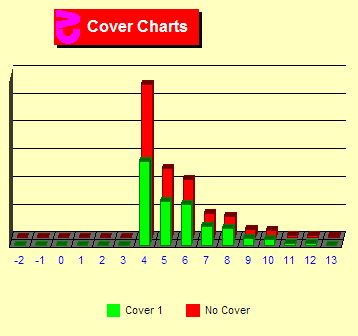 Cover
1 – No increase after a loss Cover
1 – No increase after a loss
Four types of cover will be added cumulatively. The first cover
rule used is "no increase after a loss." With this cover
method, units bet cannot be increased after losing a hand no matter
what the count. The majority of average players bet in this manner.
If you raise after a loss inconsistently, you might indicate to
the casino that you are counting.
The green bars still shows zero max bets below TC +4. But, a much
smaller number of max bets are made at TC +4 since the player is
not increasing the bet after a loss even if the TC increases. There
are fewer max bets at higher TCs also, but the red and green bars
grow closer since the TC is less likely to make large increases.
The cost in this instance is underbetting when the count is high.
And the cost can be high since the entire point of card counting
is to bet high when the count is high.
|
|
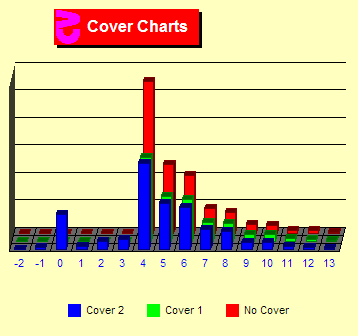 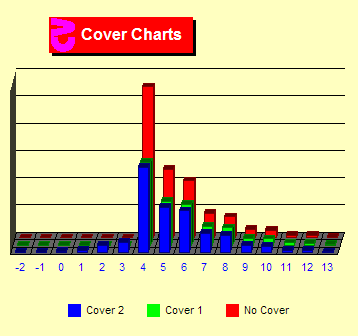 Cover
2 – No decrease after a win Cover
2 – No decrease after a win
In these charts, I add the "no decrease after win" rule.
This is the blue set of bars. There are two charts here and later
on this page depending on the player's actions at the start of a
shuffle. In the left chart the player always drops to one unit after
a shuffle. In the right chart, the player follows the cover rules.
For example, suppose you bet 16 units on the previous hand and you
won. The cover rule says that you will not decrease your bet after
a win. So you would bet 16 units even if the count dropped in the
right-hand chart. However, some people use the shuffle as an excuse
to ignore the cover rule and always drop to one unit — the
correct bet. This looks OK in shoe games but is harder to get away
with in single-deck.
At TCs +4 and above, we see about the same number of bets as not
using this rule. But, now we see that max bets are being made at
TCs +2 and +3. That is, we are sometimes overbetting at these counts.
In the right-hand chart, we also see max bets at TC 0 since we will
sometimes not be able to reduce our bet at the start of the shoe.
This is very costly since there is negative EV at TC 0.
|
|
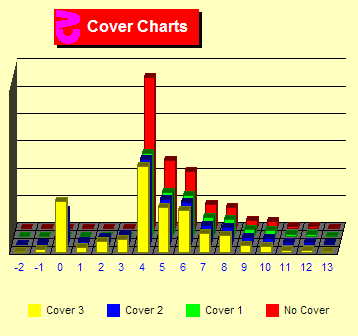 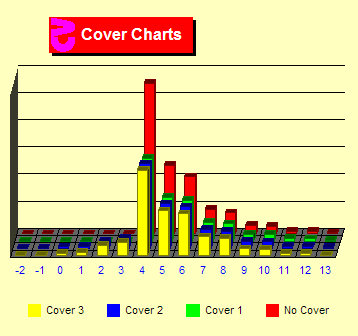 Cover
3 – Same bet after push Cover
3 – Same bet after push
Now let's add the "same bet after push" rule. Few players
change their bets after a push since there is already a bet up.
The yellow bars in the charts indicate even more overbetting at
TCs +3 and +2 and below since the rule does not allow us to change
our bet after a push even if the count changes.
|
|
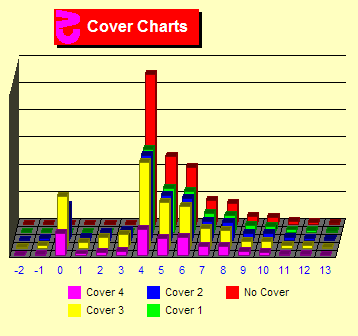 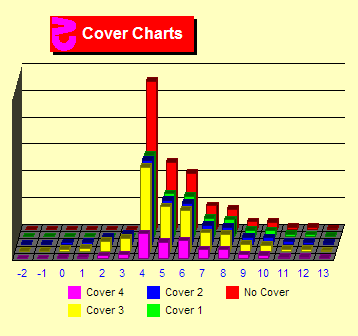 Cover
4 – No large increases or decreases Cover
4 – No large increases or decreases
OK, let's add a "no large bet changes" rule. With this
rule we cannot jump bets, like jumping from 2 to 8 or 16 to 4 units.
This is depicted by the set of violet bars. Here we show a dramatic
decline in max bets at TC +4. And, to a lesser but very significant
degree, further decreases in max bets at TCs +5 and above. This
rule is very costly when the count changes a great deal from hand
to hand. Large changes in count are more likely at full tables or
single-deck.
If we use all of the rules, we can see that we are betting our
maximum amount far less often at high counts than we should and
at times bet the max amount with a negative expectation. Clearly,
religious adherence to full cover is not practical.
|
|
Sim details
- Six decks, S17, DAS, LS, 4 players, Hi-Lo max indexes, 4.8/6
Penetration
- Eight degrees of cover
- One billion rounds each
|
|
|
 How
does cover betting affect max bets?
How
does cover betting affect max bets? Cover
1 – No increase after a loss
Cover
1 – No increase after a loss 
 Cover
2 – No decrease after a win
Cover
2 – No decrease after a win 
 Cover
3 – Same bet after push
Cover
3 – Same bet after push
 Cover
4 – No large increases or decreases
Cover
4 – No large increases or decreases